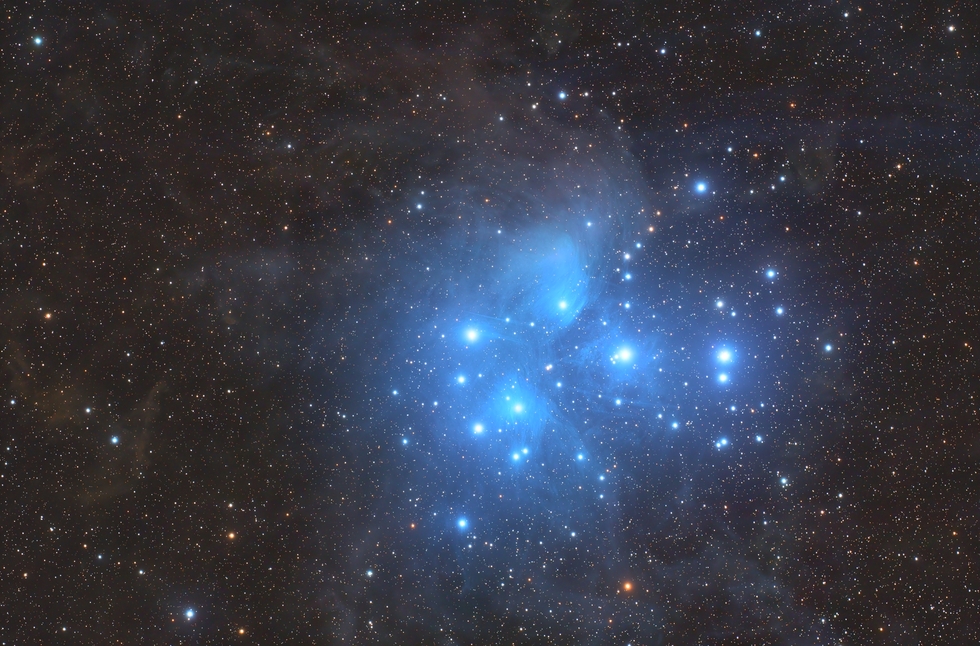Pleiades - The 7 Sisters
Pleiades - The 7 Sisters
Messier 45 (Pleiades) is an open cluster which enriched people’s imagination since ancient times. Known under many names, it is widely known as the Pleiades or the Seven Sisters. Pleiades comes from Greek and it means “to sail”, because of the cluster’s importance in delimiting the sailing season in the Mediterranean Sea.
Although the Pleiades have been named by the Greek, the cluster is known since older times. They appear in many cave paintings from the Bronze Age and have been used as a celestial compass ever since. In the 3rd millennium BC, the Pleiades were in the vernal point – one of two moments in a year when the ecliptic (the Sun’s apparent trajectory in the sly) intersects the celestial equator. The Pleiades have been used by many civilizations in their astronomical calendars: Sanskrit, Mesopotamian, Greek, Arabic. Also, they are known as Makali´i (Hawaii), Matariki (Maori), Parvin (Persia), Quliqa (=”the storehouse”, for the Quechua), Mao (China), Subaru (Japan) or Krttika (Hindi).
The oldest depiction of the Pleiades is the Nebra Sky Disc found in northern Germany, dating from 1600 BC, which shows the Sun, the Moon’s crescent and the Pleiades. This illustration, as many others until now, shows the brightest 7 stars in the cluster.
Galileo Galilei was the first astronomer to observe the cluster through a telescope, discovering 36 stars which he drew in his treatise “SIdereus Nuncius” (1610). In 1771, Charles Messier added the cluster in his catalogue, being one of the brightest objects in his list.
Messier 45 is 444 light-years away, a small distance on a cosmic scale. That’s why the cluster is visible with the naked eye, even from the city. The cluster has around 1000 stars, mostly young, blue B-type stars. Plenty brown dwarves have been found here as well – bodies with insufficient mass to turn on the nuclear fusion in their core.
The 7 sisters also have names - Alcyone, Electra, Maia, Merope, Taygeta, Celaeno and Asterope. Later on, two other stars – Atlas and Pleione – became their “parents”. The primordial nebula from which the stars were born is still around them, reflecting the intense bluish light coming from them.
The estimated age of the cluster is 75-150 million years old. The movement of the stars shows that they will be grouped for another 250 million years.
Although the Pleiades have been named by the Greek, the cluster is known since older times. They appear in many cave paintings from the Bronze Age and have been used as a celestial compass ever since. In the 3rd millennium BC, the Pleiades were in the vernal point – one of two moments in a year when the ecliptic (the Sun’s apparent trajectory in the sly) intersects the celestial equator. The Pleiades have been used by many civilizations in their astronomical calendars: Sanskrit, Mesopotamian, Greek, Arabic. Also, they are known as Makali´i (Hawaii), Matariki (Maori), Parvin (Persia), Quliqa (=”the storehouse”, for the Quechua), Mao (China), Subaru (Japan) or Krttika (Hindi).
The oldest depiction of the Pleiades is the Nebra Sky Disc found in northern Germany, dating from 1600 BC, which shows the Sun, the Moon’s crescent and the Pleiades. This illustration, as many others until now, shows the brightest 7 stars in the cluster.
Galileo Galilei was the first astronomer to observe the cluster through a telescope, discovering 36 stars which he drew in his treatise “SIdereus Nuncius” (1610). In 1771, Charles Messier added the cluster in his catalogue, being one of the brightest objects in his list.
Messier 45 is 444 light-years away, a small distance on a cosmic scale. That’s why the cluster is visible with the naked eye, even from the city. The cluster has around 1000 stars, mostly young, blue B-type stars. Plenty brown dwarves have been found here as well – bodies with insufficient mass to turn on the nuclear fusion in their core.
The 7 sisters also have names - Alcyone, Electra, Maia, Merope, Taygeta, Celaeno and Asterope. Later on, two other stars – Atlas and Pleione – became their “parents”. The primordial nebula from which the stars were born is still around them, reflecting the intense bluish light coming from them.
The estimated age of the cluster is 75-150 million years old. The movement of the stars shows that they will be grouped for another 250 million years.
SPECIFICATIONS
Telescope
Takahashi FSQ-106ED f/3.6
Camera
QHY 600M
Location
Australia
Date of observation
Sep,Oct,Nov 2023 and Jan 2024
Filters
LRGB
Processing
PixInsight



